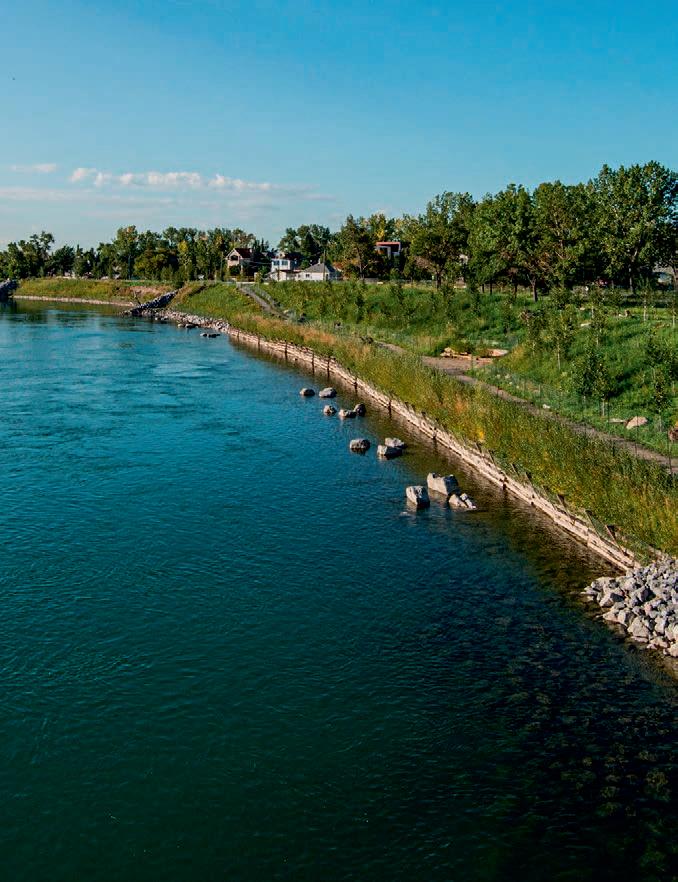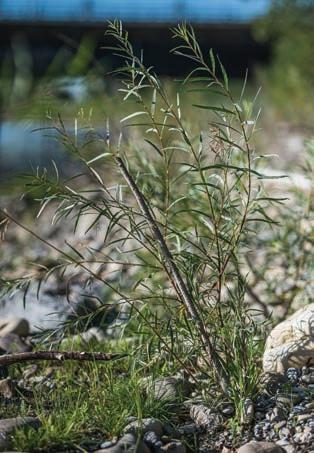
9 minute read
Demonstrating the Benefits of Bioengineering
Demonstrating the Benefits of
BIOENGINEERING
Calgary’s ‘living laboratory’ openly shares new findings.
By Mike Gallant, P.Eng.
For Alberta, the Bioengineering Demonstration and Education Project (BDEP) is a significant initiative that showcases next-generation techniques for protecting riverbanks from flooding, as an alternative to such conventional methods as rock riprap. About 100 trees, 2,300 shrubs and 30,000 live cuttings were planted to improve riparian (i.e. aquatic-terrestrial) health.
Alberta Environment and Parks partnered with the City of Calgary to undertake the BDEP to mitigate impact to fish habitats and improve riparian health along a 680-m stretch of the Bow River in the community of Inglewood, in the wake of a 2013 flood recovery program.
As design lead and engineer of record, Kerr Wood Leidal Associates (KWL) of Calgary completed the project’s design in collaboration with Hemmera Envirochem (prime consultant), Terra Erosion Control (bioengineering specialist), Polster Environmental Services (bioengineering specialist), O2 Planning & Design (landscape architect), and Thurber Engineering (geotechnical engineer) between July 2016 and September 2017, followed by construction by DFH Enterprises from February 2018 to June 2019.
The project successfully showcased both common and new techniques and openly shared its documentation, research findings and performance monitoring results through a municipal website, www.calgary.ca/BDEP, which was launched in 2020.
Novel techniques
Bioengineering is still an emerging field in Canada. In Alberta, specifically, with a low rate of vegetation survival (typically only around 50%), projects have not always been successful.
The BDEP, however, demonstrated how higher vegetation survival rates could be achieved using best practices. Indeed, through focused attention to vegetation design, installation and maintenance, performance monitoring shows the BDEP’s rate of vegetation survival is 80%.
This was accomplished by implementing 14 different techniques at 10 treatment areas with a variety of hydraulic, geotechnical and environmental conditions. Of these techniques, half were novel to Calgary, including: • three new techniques for vegetating existing riprap bank protection works to enhance aquatic habitat, wildlife passage, riparian health and esthetics. • a new vegetation preparation tech-
nique to allow for summer construction, when live cuttings should not be used, to provide construction schedule flexibility. • a new scour protection technique equivalent to riprap that uses only vegetation and locally available materials. • a new technique that combines live cuttings with rooted plants to increase biodiversity, wildlife habitat and nitrogen fixing. • a new technique that incorporates submerged refuge shelters under a timber crib wall to provide fish habitat along the bank.
Challenges and resolutions
During the 2013 flood, the Bow River’s velocity reached 4 to 5 m/s and the riverbed dropped by about 4.5 m at the site, forming the river’s deepest scour hole in Calgary. After conducting a detailed analysis, KWL designed a self-launching riprap scour apron that included rock structures for fish habitat.
When the BDEP’s design was nearly complete, a new transit bridge within the site was announced. KWL collaborated with the bridge design team to minimize the need to redesign the BDEP. They worked to increase the bridge’s dimensions to accommodate
Photo courtesy KWL.
a wildlife corridor and two BDEP viewpoints. These measures had minimal impact on the bridge’s cost and construction schedule.
The original contract included removal and disposal of historic construction debris from the riverbank. The extendt of debris, however, was larger than expected. Several change orders had to be issued to facilitate the removal and disposal of approximately 2,000 tonnes of concrete rubble, wood debris and rusting steel.
To secure an experienced contractor and reduce construction risk, the design team developed a custom tender evaluation based on price, experience and project understanding. Even with this effort, 27 site instructions and 54 requests for information had to be administered over nine months during construction.
Socioeconomic benefits
The BDEP provides many social benefits. It increases biodiversity and improves riparian health and water quality by replacing riverbank debris with native vegetation; serves to protect the historic neighbourhood of Inglewood from the next big flood; provides access to green space and an educational amphitheatre, gathering space and lookout points; helps educate the public about bioengineering and riparian health through interpretive signage; and links the Inglewood Bird Sanctuary and Pearce Estate Park with a wildlife corridor, nature trail and pathway; provides safe passage for wildlife under Cushing Bridge and the new transit bridge.
As mentioned, it also shares key information with other professionals, so they can incorporate bioengineering techniques into their own designs and improve other projects’ outcomes.
The BDEP also provided cost savings. Its final construction cost was $4.15 million; a riprap design covering the same project footprint would have cost about $5.15 million, mostly due to the import of rock riprap.
Other, unquantified economic benefits come from enhanced fish and wildlife habitats, improved water quality and new recreation opportunities.
Environmental benefits
Beyond those already mentioned, the BDEP achieved further environmental enhancements.
For one, its fish habitat enhancements—including shelters, overhanging vegetation, boulder clusters and rock spurs—were so extensive, they earned offset credits for application on another municipal project.
The design team incorporated an existing nesting area for federally protected bank swallows. During construction, it was screened off to limit disturbance. After construction, the swallows were observed returning to it.
Similarly, ongoing performance monitoring has confirmed local wildlife is using the corridors constructed for it under the aforementioned bridges.
Three techniques for retrofitting existing rock riprap erosion protection with vegetation were piloted in the BDEP. Monitoring found the resulting vegetation survival rates ranged from 60% to 97%.

Spreading the word
Technical presentations about the BDEP have been delivered at the site and at local and international conferences. In addition to KWL-initiated research with the University of Calgary, the project’s contract documents have been used as a template for 10 other projects within the same overall flood recovery program. The performance monitoring program is still underway, with a 10-year duration, evaluating and reporting on the project’s impact on fish habitat, wildlife, riparian health and bioengineering structural integrity. The first year’s results have already shown the BDEP’s effectiveness exceeds expectations. CCE
About 100 trees, 2,300 shrubs and 30,000 live cuttings were planted.
There were significant cost savings compared to a conventional approach.
Mike Gallant, P.Eng., is a senior water resources engineer with KWL. » Stormwater » Civil Infrastructure » Facilities Design » Community » Water Resources Infrastructure & Development » Wastewater » Energy » Environment » Utility Management » Water Supply & Treatment » Electrical Greater Vancouver | Vancouver Island Calgary | Okanagan | Kootenays For more information visit, kwl.ca

MAKING THE MOST OF
R&D INCENTIVES

Pioneering engineers should benefit from innovation.
By Richard Hoy
Canada’s engineering industry represents one of the most innovative sectors in the country and is responsible for construction and infrastructure projects of crucial importance to the economy. Yet, many consulting engineers are not aware of available tax incentives that can be reinvested in this kind of work and of the assistance to which they may be eligible.
It is worthwhile to understand the relevant scheme, what kind of activity qualifies for it and how to go about claiming it.
The SR&ED program
Tax credits for innovation are available in Canada through the Scientific Research & Experimental Development (SR&ED) program. Taking advantage of these credits can go a long way towards easing the costs of an engineering project.
Many professional engineers wrongly assume such tax incentives awarded for research and develop- worthwhile for all consulting engiment (R&D) are the preserve of the neers to get a grip on how the proscientific community, but the federal gram works. government has been very careful not For one thing, it is not to be conto exclude any sector. The rules are fused with the Industrial Research actually very generic and can apply to Assistance Program (IRAP), which many industries. makes government-funded grants
Further, contractor costs also quali- available to small and medium enterfy for incentives. So, firms using third- prises (SMES), rather than tax incenparty engineering expertise for R&D- tives for R&D. related activity can benefit. That said, the SR&ED regime for
Indeed, the cost of hiring consult- SMEs has improved recently. There ing engineers can form part of an over- has never been a better time to claim. all SR&ED claim. With this in mind, clients should be asking engineers to Work that qualifies provide evidence of their R&D work The SR&ED program’s rewarding tax to support their own claims. incentive for innovation allows busi-
If you are not being nesses to claim back up asked about this, but you Tax credits to 41.5% of expenses know you are perform- can go a incurred through R&Ding work that is likely to long way in related activity. It reprequalify, then there is an easing the sents a combination of opportunity to add more costs of an federal and provincial value by alerting that cli- engineering incentives, so it varies by ent to the opportunity project. province. to claim. To this end, it’s Not every cost associ-
ated with R&D can be included in a claim. The main qualifying expenses include staff costs, salaries, materials and payments to contractors and third parties.
Consulting engineering firms and individual professionals are likely to perform qualifying SR&ED activity. By way of example, consider the ongoing development of renewable energy sources. While Canada has a long history of fossil fuels, it is also becoming one of the world’s strongest champions of renewable energy, with much innovation in this sector that would qualify for SR&ED incentives.
From the point of generation to load centres, each facility needed to deliver clean energy to homes and businesses requires new technology and processes. The high-voltage direct current (HVDC) transmission market, for instance, is one area of the energy industry that is set to expand in the coming years, as innovation steadily increases.
The incentive for a private business is received as a cash payment. For publicly traded companies, it is a credit to be offset against outstanding taxes.
The best way to check what qualifies is to work with seasoned tax advisers who are experienced in SR&ED claims. By doing so, consulting engineers have a strong opportunity to improve the value they offer to their clients, guiding them as to where they should be using and benefitting from the program.
Broadly speaking, there are three simple tests to identify what innovations might qualify for these tax incentives. The work must: • further technical knowledge or create advancement in the industry. • overcome scientific or technological uncertainties. • do something, by design, that other professionals would find difficult or not obvious. Businesses can claim up to 18 months after the tax year in which the innovation took place. So, if you didn’t know about the scheme before, there still is a good chance you or your clients could claim substantial amounts retroactively.
And at a time when some businesses are struggling financially due to the COVID-19 pandemic and many projects have been put on hold, now is the perfect moment to make sure you are taking full advantage. CCE
The cost of hiring consulting engineers can form part of an overall SR&ED claim.
Richard Hoy is president of specialist tax consultancy Catax Canada. He can be reached at richard.hoy@catax.com.








